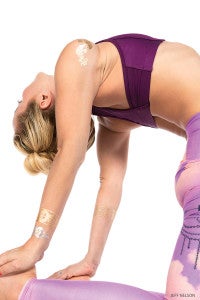Heading out the door? Read this article on the new Outside+ app available now on iOS devices for members! Download the app.
ALSO WATCHYogapedia Video: Camel Pose (Ustrasana)
NEXT STEP IN YOGAPEDIAModify Camel Pose (Ustrasana)
SEE ALL ENTRIES IN YOGAPEDIA
Benefit
Strengthens the back; opens the shoulders, chest, and quadriceps; boosts mood and energy.
Instruction
1 Come to your knees, with your legs hip-width apart. Place your hands on your hips, with your thumbs on your sacrum, the bony plate at the base of your spine. Keep your hips over your knees and internally rotate your thighs, squeezing them toward each other.
2 Inhale to engage your lower belly and reach your tailbone toward your knees, creating space between your lower vertebrae.
3 On another inhalation, lift your sternum and draw your elbows toward each other, allowing your rib cage to expand.
4 Keep your chest raised, your core engaged, your spine long, and your chin tucked as you drop your hands toward your heels.
5 Press the heels of your hands into the heels of your feet while draping the fingers over the soles. Keep lifting through your sternum.
6 Now lift your shoulders to allow the trapezius muscles between the shoulder blades to rise up and cushion your cervical spine. Gently lower the head and neck and gaze at the tip of your nose.
7 To exit the posture, bring your chin back toward your chest and your hands to your hips with your thumbs on your sacrum. Engage your lower belly and use your hands to support your lower back as you come up slowly.
Avoid These Mistakes

DON’T pinch the shoulders together, tensing the neck.

DON’T crunch the lower back by squeezing the butt, pushing the knees wider than hip-width apart, or pooching the belly.
Focus Inward
Backbending is a journey into the nervous system and all of the emotions our nerves and sense organs can trigger—from fear to elation. When practiced slowly and safely, backbends like Ustrasana and Kapotasana have the power to reset your response to stress. Backbending trains the mind to remain equanimous in the face of adversity, requiring you to move carefully as you work with the limitations of your body and mind. As you extend your spine backward, you have to learn to distinguish between muscular and emotional intensity and between safe physical challenges and unsafe joint pain. Use your breath to cultivate a clear, calm mind, which can help you focus on and detect subtle sensations, such as strain within, rather than letting your ego be the driver of your asana practice, which can force your body into an aesthetic shape for which you may not be ready.
See alsoAdvanced Backbends Are Within Reach
Our Pro Teacher and model
Our Pro Teacher and model Kino MacGregor is a certified Ashtanga Yoga teacher; the author and producer of multiple yoga books, DVDs, and online courses; co-founder of Miami Life Center; and founder of Miami Yoga Magazine. Learn more at kinoyoga.com and @kinoyoga.